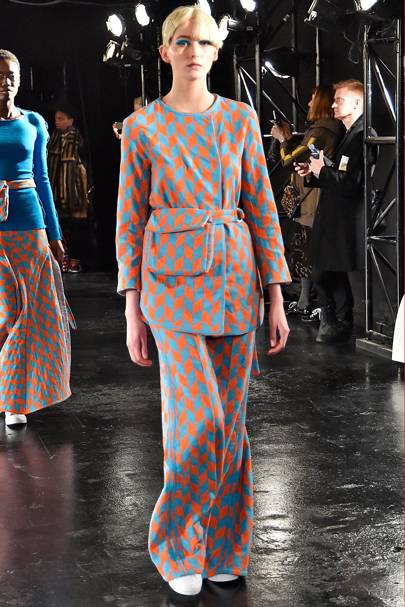Such a problem simply doesn’t come into play with Irish talent Richard Malone, who started his eponymous brand by creating custom pieces for private clients who spotted his designs in Dublin's Brown Thomas department store (their buyers snapped up his entire graduate collection). These women not only operated as the initial backbone for Malone’s business, providing the financial support that he needed to go forward with his brand, but equally proved to be the foundation for the philosophy behind his designs. “The feedback all of those clients gave me really informed my work,” he says now, a few years down the line, as he prepares for his first fashion show supported by the NEWGEN fashion fund. “We would have conversations about inspiration, and so the whole process becomes a lot more honest, and a lot more functional.”

One of the common problems that plagues young designers is that they can all too easily forget that the clothes they are wearing might, hopefully, be bought and worn by a woman – after all, if you aren’t used to selling, then it can be all too easy to get caught up in concept and forget about your customer.
That’s certainly not to say that what Malone designs is prosaic – his collections are anything but, filled with remarkable shapes, geometric patterns and good/bad taste colours. In fact, all it means is that the clothes that he designs incorporate elements like pockets or well-positioned fastenings, that they wrap around and flatter the body, and are always made from the sorts of material that you will be actually able to wash (in fact, early on in his career, one of his proudest achievements was that he’d made a machine-washable showpiece). Even the more avant-garde, sculptural showpieces he creates are so cleverly designed that, after being packed into a suitcase, they spring into shape. It might sound like common sense but, in an industry that can quickly forget about the women who invest in its success, it is anything but.

Besides the consideration he exhibits for women and their bodies, another of Malone’s remarkably compelling characteristics is that he is dedicated to sustainability – but without falling into the tiresome or worthy narratives that often surround such a missive. He grew up in Wexford, a small county in southeast Ireland, in the midst of a recession, and thus quickly learned how to make do and mend; his graduate university collection was made from leftovers that he found in his father’s shed after he had lost his job on a building site. Over the years, such an approach has developed into resolute resourcefulness executed with refined finesse; in fact, his spring/summer 2018 collection uses a fabric made from the bark of eucalyptus trees, which is as malleable as polyester but with the appearance of silk. “I think it’s the only way you can do something that is really contemporary,” he explains. “You really need to consider where it’s coming from – and I think the customers really want to know about that side of things.”
That’s the thing with Malone – that, no matter what he’s talking about, he always returns to the women who might buy his pieces, women like Belmacz founder Julia Muggenburg, or MoMa curator Paola Antonelli (who is including one of his pieces in upcoming show Is Fashion Modern?). “I get a lot of feedback from my customers about why they’re not buying clothes from the megabrands, and it’s because there’s a lot less consideration for their bodies and their image than there used to be,” he says. “Hearing them talk is so important to how I design, how I cast my show, for the consideration I have for clothes. Hearing that they buy Yohji Yamamoto – and not just because it’s beautiful, but because it’s functional, too – is nice, and it’s important to remember.” Important, yes – and something which sets him in good stead for seasons to come.



No comments:
Post a Comment